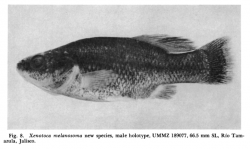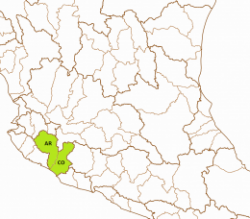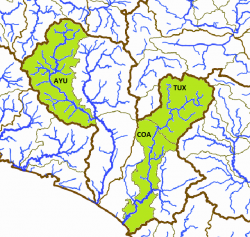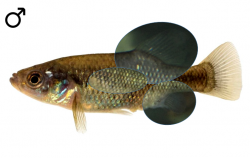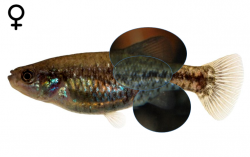- HOME
- WHO WE ARE
- NEWS AND DATES
- GOODEIDS
- PHYLOGENY
- ARTIFICIAL KEY
- GOODEID SPECIES
- BIOLOGY
- ENVIRONMENT
- CONSERVATION
- PROFUNDULIDS
- MEMBERS AREA
"Xenotoca" melanosoma
English Name:
Black Splitfin
Mexican Name:
Mexclapique (erronously: Mexcalpique) negro
Original Description:
FITZSIMONS, J. M. (1972): A revision of two genera of Goodeid fishes (Cyprinodontiformes, Osteichthyes) from the Mexican Plateau: Copeia 4: pp 728-756
Holotype:
Collection-number: University of Michigan Museum of Zoology, Cat. No. UMMZ-189077.
The Holotype is a mature male of 65.5mm standard length, collected by R. R. Miller and H. L. Huddle on April the 03rd, 1968. Together with this specimen were taken a female Allotype of 76mm SL (UMMZ-189078) and 21 Paratopotypes, three males and 18 females (UMMZ-189079), 48 to 78.5mm long (SL). More Paratopotypes (UMMZ-186292), seven males and seven females, were taken by the same collectors two years earlier, May the 03rd, 1966.
Photo of the Holotype (left) and Allotype (right) of "Xenotoca" melanosoma:
Terra typica:
Etymology:
The epithet of this species is derived from the Greek. It is composed of mélas (μέλας), black, and soma (σῶμα), body, so melanosoma means translated "black body". This is a diagnostic feature of this species.
This species belongs to an undescribed genus, but until the changement has happened, it stays integrated in Xenotoca. The genus Xenotoca was erected for Characodon variatus by Hubbs and Turner in Turner, 1937, because "this species differs from Characodon (lateralis) in numerous internal as well as external features. Characters distinguishing Xenotoca from Characodon involve the ovarian anatomy, the form and structure of the trophotaeniae, and some superficial features". The generic name can be derived from the ancient Greek with the word ξένος (xénos) meaning strange and and τόκος (tókos) offspring. Xenotoca can therefore be translated with "a strange type of offspring".
Synonyms:
none
Distribution and ESU's:
The Black Splitfin is endemic to the Mexican federal state of Jalisco. It was orginially described from the Upper Río Tuxpán drainage including the ríos Tamazula and San Gregorio, the Arroyo Tecalitlán and the Río El Terrero, an affluent of the Río Naranjo, all Río Coahuayana drainage. It was additionally described from a section of the Río Ayuquila, Río Armería drainage. From its affiliation to different drainages, three subpopulations can be inferred: The Río Tuxpán subpopulation (type subpopulation), the Río El Terrero subpopulation and the Río Ayuquila subpopulation. The bold names are the ones officially used by the Instituto Nacional de Estadística y Geografía; nevertheless, other ones might be more often in use or better known and therefore prefered.
ESU ist short for Evolutionarily Significant Unit. Each unit expresses an isolated population with different genetic characteristics within one species. ESU's can be defined by Molecular genetics, Morphology and/or Zoogeography and help in indicating different phylogenetic lineages within a species. The abbreviation for an ESU is composed of three letters of the genus, followed by the first two letters of the species name and an ongoing number in each species.
In "Xenotoca" melanosoma - with respects to the population from the Río Ayuquila - we are by now not able to distinguish different ESU's. It may be that both known populations will have to be treated as separate ESU's, but due to little information, they are encompassed within one ESU: Xenme3. Other ESU's still ranked as "Xenotoca" melanosoma belong to a spearate not yet described species.
The left map shows the ríos Coahuayana (CO) and Armería (AR) basins from the Hydrographic Region Armería-Coahuayana on a Mexico map. The Black Splitfin is known from the Río Coahuayana subbasin (COA), where it occured in the northern borderlands, but seems to be extinct nowadays, and from the Río Tuxpan (TUX) subbasin, where the species might still exist in very lowe numbers. The "Xenotoca" melanosoma from the Río Ayuquila subbasin (AYU) were last seen in 2004, might be gone as well, but of these are stocks kept in aquariums. The right map shows all the historically populated subbasins:
Status :
International Union for Conservation of Nature (IUCN): Endangered
Distribution and current conservation status of the Mexican Goodeidae (Lyons et al., 2019): Vulnerable/declining (including "Xenotoca" cf. melanosoma): „This species is found in the Santiago, Ameca, Armería, and Coahuayana river basins and the endorheic Magdalena, Atotonilco, San Marcos, Zacoalco, Sayula, and Zapotlán lake basins in Jalisco (Miller et al., 2005). We recognize four ESUs based on genetics and zoogeography (Domínguez-Domínguez et al., 2010; Mar-Silva, 2018). Xenme1 is by far the most numerous and widely distributed and is classified as vulnerable. It is found in the Ameca, Magdalena, Atotonilco, San Marcos, Zacoalco, and Sayula basins at a total of ca. 15 locations. It has declined since 2000 owing to water pollution, habitat degradation, and non-native species. It has disappeared from the San Marcos and Zacoalco basin and persists at only 1–3 locations in the Magdalena, Atotonilco, and Sayula basins. The best remaining populations are in the Ameca basin. Xenme2 is critically endangered and is known from Lake Zapotlán where it is rare and in decline from habitat modifications and non-native species. Xenme3 is endangered and currently known from two locations on the upper Tamazula River where it is threatened by water diversions and introduced species. Xenme4 is also endangered and is limited to a short reach of the Ayuquila River downstream of the city of El Grullo in the Armería River basin, where chronic water quality degradation limits the population.“
NOM-059-SEMARNAT-2010: Categoría de riesgo (Category of risk): P - En Peligro de Extinción (in danger of extinction)
Habitat:
The Black Splitfin lives in ponds, streams and lakes with clear to muddy water over substrates of mud, sand, gravel, rocks, boulders and bedrock. There is either no vegetation or green algae, Cyperus, Eleocharis, Potamogeton, water hyacinths, Lemna, Nasturtium, Scirpus and Typha. The currents are none to moderate. Like most of the Goodeids, it prefers depths of less than 1m. It seems to be not very abundant in the habitats as it is rarely observed. Surveys of the GWG to the known habitats within the Río Coahuayana drainage in 2016, 2018 and March 2019 were inconclusive. The Río Tecalitlán is heavily polluted and didn't reveal a fish at all in November 2018 and March 2019.
Biology:
Young were captured in late spring, indicating a reproduction from at least March to May. Due to the fact, that this species is probably Exinct in the Wild, little is known about its life history.
Diet:
The dentition is similar to "Xenotoca" eiseni suggesting an omnivorous feeding behaviour, nevertheless feeding predominantly on aquatic animals and lesser amounts of algae and aufwuchs. As Black and Redtail Splitfin mostly occur as a species pair, it is very likely, that they use different food sources. In this case, the Black Splitfins are the more carnivorous representatives of the genus while the Redtail Splitfins feed mainly from herbivorous food sources.
Size:
The maximum known standard length is 85mm (Miller et al., 2005).
Colouration:
Here is the description of the colouration, given by Fitzsimons in 1972: "Against a dark background, adult males may be nearly jet-black, with only the cheek below the eye, and the chin, and the throat and breast region remaining sligthly paler. Immature males or mature males against a light background are uniformly gray along the sides and somewhat darker, with an irregular pattern of small, indistinct spots on the head, nape and back. The chin, breast and abdomen are light gray to grayish white. Depending on the background and size of the fish, the dorsal fin is dusky to black. In large males over 60mm SL the caudal fin may be almost uniformly black. In males approximately 40 to 55mm SL, a concentration of pigment at the base of the principal caudal rays may appear as a poorly defined curved bar or blotch approximately the width of the orbit; in males less than 25mm SL, the basal dark blotch is lacking and the fin appears pale gray to clear. The anal fin is dusky to black but with the membranes of the first six rays, and a narrow marginal band on the membranes of the remaining rays, relatively pigment-free. The paired fins are pale gray to dusky. The dark colouration of males fades considerably in preservative. Females are also dark-bodied but their fins lack the heavy pigmentation seen in males; paired and median fins are palegray to clear. The opercle is pale silvery. The chin, throat and breast are pale gray-white and, in larger females, often lightly speckled. Barring and spotting on the sides of the body and caudal peduncle are conspicuous in immatures and adults against a light background and can be seen even in very large, dark females after preservation. Three to eight scattered vertical bars, varying in length from one to three times an eye diameter, occur on the sides of the body between the pectoral base and the anal origin. In some females they are evenly distributed but in others they may occur in three or more clumps. They are best developed in females 40 to 60mm SL but are less distinct in larger and darker females. An irregular row of five to eight (mostly six) dark spots extends along the midlateral line from the caudal base forward onto the body above the anal origin. Viewed from a distance, the spots often appear as a vague stripe about an eye diameter in width. Speckling is pronounced on the sides and venter of the caudal peduncle but is largely obliterated dorsally by countershading. The venter of courted, sexually responsive females is a brilliant iridescent blue. This colour is transient; it is seen only in the presence of males and quickly fades to an inconspicuous blue- or gray-white when females are disturbed. The venter of immature or sexually unresponsive females is pale white to gray-white."
Sexual Dimorphism:
Males and females of the Black Splitfin are not so easy to distinguish. The safest characteristic is the Splitfin in males, means the for Goodeinae typical mating organ formed by a notch after the first seven shortened rays of the Anal fin. Additionally, male "Xenotoca" melanosoma have a bigger Dorsal fin than females. A third, but not so distinct character is the colouration with the males being unicoloured brownish copper, getting very dark when courting, while females have a white to whitish belly, a brown back, a dark midline and several spots and blotches on back and belly.
Remarks:
A population of Black Splitfins is known from the Río Ayuquila, Río Armería drainage, about 10km S of the town of El Grullo. The species cooccurs or cooccured with a population of (probably) "Xenotoca" lyonsi, forming a species pair between Redtail and Black Splitfins, like it can be found almost everywhere where a representative of these species lives, except for Nayarit and "Xenotoca" eiseni. As this pair inhabits or inhabited a river of the Armería-Coahuayana basin, it is likely, that it is or was either a separate population of "Xenotoca" melanosoma or (in contrast to the Northern Black Splitfins) a very closely related species. Phylogenetic tests (Domínguez-Domínguez, 2011; Mar-Silva, 2013) support that the populations from the ríos Armería and Coahuayana drainages are conspecific and form a lineage, that is clearly recognizable and distinct from the populations north of these basins. These northern populations belong to a not yet described species: "Xenotoca" cf. melanosoma.
Already hybridisation studies of Fitzsimons (1972) revealed a close relationship of this species with "Xenotoca" eiseni, but not with Xenotoca variata. The Redtail Splitfin, its closest relatives (doadrioi and lyonsi) and the two species of Black Splitfins do not belong to the genus Xenotoca. Shane Anthony Webb (1998) proposed a new generic name in his thesis for these species, that has not been published officially (Xenotichthys). The reason therefore is the US-American jurisdiction, that a thesis doesn't count as an official publication. Therefore R. R. Miller segregated the generic name by quotation marks, a system, we follow in the GWG.
Husbandry:
Looking on the habitats of "Xenotoca" melanosoma, they suggest the species may prefer a habitat with moderate to swift current, structured with rocks, roots and small areas with dense submerse vegetation. Intraspecific aggession is sometimes observed, mostly between males of same size. Fry is eaten in most of the cases, but it may depend on the quantity and quality of food and on the number of places to hide. When several different stages of juveniles occur, fry may be neglected, so it makes sense to add separate brought up fry to the group with a size of 2 to 2.5cm to provide these stages and get a flock breeding colony.
The recommended tank size is at least 250 liters, bigger tanks with a generous base and little height (25cm are enough) are better for sure. A bit with roots and/or rocks structured tanks with few patches of dense submerse vegetation in the corners and bigger free areas to swim seem to do best with this species. The current should be moderate, especially as the oxygene level should be quite high (at least 8mg/l).
In the wild, adults of this species feed mainly from Crustaceans, worms, insect larvae and other middle sized invertebrates, but also from aufwuchs, so feeding with fiber-rich middle sized food from animalistic sources will be best for this fish. In aquarium, it feeds very well from flake food, granulate and tablets, additionally freeze dried food like Brine Shrimps is eaten greedy. The species is anything else but shy.
Concerning water quality, this species is in need of bigger water changes (60-80% every week) like most of the Goodeids, especially spring and river inhabiting species. Therefore an automatic water changing system can be helpful. Otherwise, in combination with constant temperatures higher than 25°C, fish may get sick, lose resistance against diseases and age too fast. So for keeping the strain healthy and strong, give the fish a rest during winter time with temperatures lower than 20°C for 2 or 3 months so they stop producing fry. In spring, when the temperature slowly increases, they will start spawning at 20 or 21°C and won't stop until it gets colder again or when it gets too warm (25°C).
This species does very well when is kept in the open from spring to fall, starting when the water temperature by day exceeds 17°C (depending on population) and cold periods are no longer expected. Bring them out in the early afternoon, the time of the day with the highest water temperature. During the warm summer, reproduction will stop and may occur again in fall. Bring the fish in before the water temperature deceeds 17°C (depending on population) by day and keep them cool for the first days, then slowly raise the temperature but try to stay below 20°C over the winter time.
Populations in holding:
Here each species are assigned populations of fish in husbandry and in brackets aliases of these locations to assist in identifying own stocks. Each population is assigned a unique Population-ID, composed by the ESU, the subbasin where this population is occurring (three capital letters) and a unique location identifier.
Populations in holding:
1. Xenme3-AYU-RAyu
Population: Río Ayuquila
Hydrographic region: Armería-Coahuayana
Basin: Río Armería
Subbasin: Río Ayuquila
Locality: Rio Ayuquila at "Achacales", about 1 km from Aguacate, 23km SE of Autlán




